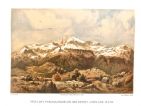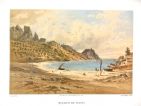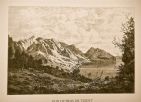
Puig Major in Sóller and La Calobra
"From charming little Biniaraix, a rocky, stepped path climbs along the left slope of Fornalutx Valley, providing pretty views of the “barranc” and the valley with the picturesque fortified house in Binibassí. We cross some plantations of olive trees growing in terraces at different heights and, on the right, pass by the path that climbs to the “barranc” as well as to Lluc. Instead, we take the oblique branch of the path towards Puig Major. Over some steps, some of which are natural, others artificial, the path runs stubbornly over rocky conglomerate until finding the path from Fornalutx. We pass next to the small pool formed by the Font de la Marturella spring on the path and, there, before us, is the impressive and colossal Puig Major.
 Behind us are some small houses, and we come to the Cabana plain. On one side it’s framed by cliffs with sparse shrubs and the smooth green of vines; on the other are the craggy heights of Fornalutx’ coast. After some gigantic stone blocks we come to a wall which defines the limits of Cabana in a dense Holm oak grove. The view from here of Puig Major is impressive. The stone-paved path continues winding uphill. Two new tiled-roof cabins to gather snow appear within view still as we ascend. What a beautiful view of the rocky outcroppings framing the top part of this valley, with the most faraway peaks already very faded and the distant sea! We cross over the Des Coll des Puig separating wall to find the wide and enchanting panoramic view of the ravines and heights of Son Torrella and Almallutx, as well as the crags of the peak, with Cap Formentor serving as the backdrop. The path is increasingly worse but it continues on winding up to the very summit, allowing horse riders to top this mountain at 1,445.22 m above sea level without ever dismounting. Worth noting is the extraordinary view: the sea all around except for the part around Lluc where the second tallest peak on the island, Puig Major de Lluc also known as Puig de Massanella, hides the sea from view. Words cannot describe the sight. Indubitably, it is one of the most beautiful mountain panoramic views in all the Mediterranean. Building a hostel here would certainly be worthwhile. It could also serve as a shelter for those making this ascent, resulting in a much more attractive place for potential visitors.
Behind us are some small houses, and we come to the Cabana plain. On one side it’s framed by cliffs with sparse shrubs and the smooth green of vines; on the other are the craggy heights of Fornalutx’ coast. After some gigantic stone blocks we come to a wall which defines the limits of Cabana in a dense Holm oak grove. The view from here of Puig Major is impressive. The stone-paved path continues winding uphill. Two new tiled-roof cabins to gather snow appear within view still as we ascend. What a beautiful view of the rocky outcroppings framing the top part of this valley, with the most faraway peaks already very faded and the distant sea! We cross over the Des Coll des Puig separating wall to find the wide and enchanting panoramic view of the ravines and heights of Son Torrella and Almallutx, as well as the crags of the peak, with Cap Formentor serving as the backdrop. The path is increasingly worse but it continues on winding up to the very summit, allowing horse riders to top this mountain at 1,445.22 m above sea level without ever dismounting. Worth noting is the extraordinary view: the sea all around except for the part around Lluc where the second tallest peak on the island, Puig Major de Lluc also known as Puig de Massanella, hides the sea from view. Words cannot describe the sight. Indubitably, it is one of the most beautiful mountain panoramic views in all the Mediterranean. Building a hostel here would certainly be worthwhile. It could also serve as a shelter for those making this ascent, resulting in a much more attractive place for potential visitors.
.jpg) If, from behind the small hollow above Monnàber, we take the path we left behind to our left in search of the more northern peaks, we soon come to a ledge from which we have a splendid panoramic view reaching all the way to the house on Teix. The path continues to a rocky ravine, Es Caragoler, above the Montcaire property with an immense hackberry at its entrance and famous for its walnuts. The path continues to the left of Es Caragoler and runs along a small spring which feeds a trough. To the right is the three-headed Puig Major colossus. To the left is the valley extending towards the two Binis. The path descends now tiresomely, offering us views of both Binis beyond a multitude of fallen crags, innumerable masses of reeds, a legion of “vangélicas” and the forward guard of the pine trees which farther on become the dominant vegetation. On opposite sides of the valley we find Bini de la Marquesa and Bini d’En Palou. We now leave the main valley and enter a side plain, Es Pla d’en Gumbal, in which we find two puddles at the end. There are some large rocky masses forming a natural pyramid on the right of this little valley. We circle around a new hollow at the base of the second and last promontory of Puig Major and leave behind two shacks in front of which is a deep chasm. The ravine that follows offers a splendid view of the steep surroundings and the distant sea. A few steps farther and we enter the Sa Calobra valley which will take us to the sea, comforting us along the way with the view of tall and remote Puig Tomir, Tuent tower and, in the forefront, the grey, picturesque rocky masses eroded by the trickle of rainfall.
If, from behind the small hollow above Monnàber, we take the path we left behind to our left in search of the more northern peaks, we soon come to a ledge from which we have a splendid panoramic view reaching all the way to the house on Teix. The path continues to a rocky ravine, Es Caragoler, above the Montcaire property with an immense hackberry at its entrance and famous for its walnuts. The path continues to the left of Es Caragoler and runs along a small spring which feeds a trough. To the right is the three-headed Puig Major colossus. To the left is the valley extending towards the two Binis. The path descends now tiresomely, offering us views of both Binis beyond a multitude of fallen crags, innumerable masses of reeds, a legion of “vangélicas” and the forward guard of the pine trees which farther on become the dominant vegetation. On opposite sides of the valley we find Bini de la Marquesa and Bini d’En Palou. We now leave the main valley and enter a side plain, Es Pla d’en Gumbal, in which we find two puddles at the end. There are some large rocky masses forming a natural pyramid on the right of this little valley. We circle around a new hollow at the base of the second and last promontory of Puig Major and leave behind two shacks in front of which is a deep chasm. The ravine that follows offers a splendid view of the steep surroundings and the distant sea. A few steps farther and we enter the Sa Calobra valley which will take us to the sea, comforting us along the way with the view of tall and remote Puig Tomir, Tuent tower and, in the forefront, the grey, picturesque rocky masses eroded by the trickle of rainfall.
 The path continues along the irregular slope, crowned by large stone blocks and reaching to the heights of Mola de Tuent to gradually descend down the latter amongst slopes covered completely in reeds.
The path continues along the irregular slope, crowned by large stone blocks and reaching to the heights of Mola de Tuent to gradually descend down the latter amongst slopes covered completely in reeds.
From Can Palou, the stone path heads towards Sa Calobra, signaled by the presence of Sant Llorenç Chruch in the middle of the pass.
Sa Calobra’s soil is black with reddish tones and consists of eight houses along with Can Termes and Can Pau, the latter two sharing a “tafona” (flour mill) with a “biga” (beam) and millstone. The Font de Sa Calobra spring above the houses is fairly abundant and feeds a nearby “safareig”. Can Pau, with its square tower overlooking the valley, is in the middle of a hollow which prolongs the valley and is known as Es Racó. From here a path climbs up to the houses. The group of dwellings still has a shared tower though modern in structure. Old elm and walnut trees, plus isolated lemon, cherry, fig, pomegranate and orange trees liven up the setting.
 From the path which leads to Port de Sa Calobra, another rocky and steep path climbs up amongst reeds and shrubs up to the heights that were once tilled. We should recognize that one such plot still exists. The path continues towards the Torre de Sa Calobra also known as Sa Penya Roja which overlooks the crags bordering the marsh. From here we see the tortured outcroppings carved by the rain and under the shadow of Puig Major, the Torrent de Pareis ravine with the two hills that border the port and a part of Sa Calobra valley. The round tower, built in 1596, has been slightly leveled at the base. It measures 7 “varas” in diameter and has a parapet with a platform and a square door protected up high by windows with arrow-slits in very solid walls built inwardly.
From the path which leads to Port de Sa Calobra, another rocky and steep path climbs up amongst reeds and shrubs up to the heights that were once tilled. We should recognize that one such plot still exists. The path continues towards the Torre de Sa Calobra also known as Sa Penya Roja which overlooks the crags bordering the marsh. From here we see the tortured outcroppings carved by the rain and under the shadow of Puig Major, the Torrent de Pareis ravine with the two hills that border the port and a part of Sa Calobra valley. The round tower, built in 1596, has been slightly leveled at the base. It measures 7 “varas” in diameter and has a parapet with a platform and a square door protected up high by windows with arrow-slits in very solid walls built inwardly.
The path descends from Can Palou through olive and carob tree plantations while offering an intimate and limited panoramic view of the port in Tuent. The ground is coppery in color here and an ochre lime there.
 The barely tillable ground in Tuent is populated by olive and carob trees. To the right of the valley, in the middle of the grey-blue olive grove, Can Palou and Can Xispa stand out.
The barely tillable ground in Tuent is populated by olive and carob trees. To the right of the valley, in the middle of the grey-blue olive grove, Can Palou and Can Xispa stand out.
 After crossing over the wide torrent which crosses the valley of Tuent, a slow climb begins along the stepped stone path on the other slope. We progressively begin to see more of the sandy beach below, where the fishermen often shore their boats. The land is organized into terraces of olive trees, carefully cultivated between large blocks of stone. We pass by the Capapuig house, a simple yet elegant farmhouse with a half-point arch entrance and a majestic hackberry at the door. The cliffs of the “mola” reveal their rustic beauty. We reach Serradell de Capapuig just after Costera, where there is a separating wall next to which some pines grow. The view of the west is as pretty as that of Tuent valley we’ve just left behind. To the left, the path comes to Sa Cova de Sa Costera, a cave with a stalactite in the middle resembling a prop which, along with the picturesque port in the background and the sun creating a tenuous mist, creates such a mysterious and beautiful image.
After crossing over the wide torrent which crosses the valley of Tuent, a slow climb begins along the stepped stone path on the other slope. We progressively begin to see more of the sandy beach below, where the fishermen often shore their boats. The land is organized into terraces of olive trees, carefully cultivated between large blocks of stone. We pass by the Capapuig house, a simple yet elegant farmhouse with a half-point arch entrance and a majestic hackberry at the door. The cliffs of the “mola” reveal their rustic beauty. We reach Serradell de Capapuig just after Costera, where there is a separating wall next to which some pines grow. The view of the west is as pretty as that of Tuent valley we’ve just left behind. To the left, the path comes to Sa Cova de Sa Costera, a cave with a stalactite in the middle resembling a prop which, along with the picturesque port in the background and the sun creating a tenuous mist, creates such a mysterious and beautiful image.
Near the sea, the Sa Font des Verger spring bubbles up, one of Mallorca’s most abundant. According to tradition, the water was once used in a smelt for iron extracted nearby and where we can still see the ruins of the old building.
The path winds upwards to the first valley. To the right we leave behind Costera, and, after crossing over a separating wall, we slowly continue along the Coll de Biniamar hill up where some Holm oaks grow and lush reeds prosper. Coll de la Seca also known as Coll de Bàlitx la Torre Seca is crowned by a building which was ordered built in 1580 and finished in 1584. The path now crosses over some sandstone spotted with large blocks of fantastically shaped rocks. It then descends to the valley of Bàlitx with its terraces of olive trees and where there once was a farmhouse. In the middle of this vast valley and not far from a lush orange grove is the majestic Bàlitx d’Avall house."
Archduke Ludwig Salvator of Austria. Las Baleares por la palabra y el grabado. Majorca: The island. Ed. Sa Nostra, Caja de Baleares. Palma de Mallorca. 1982.













.jpg)










